History of WordPress: WordPress UI Evolution + Other Improvements
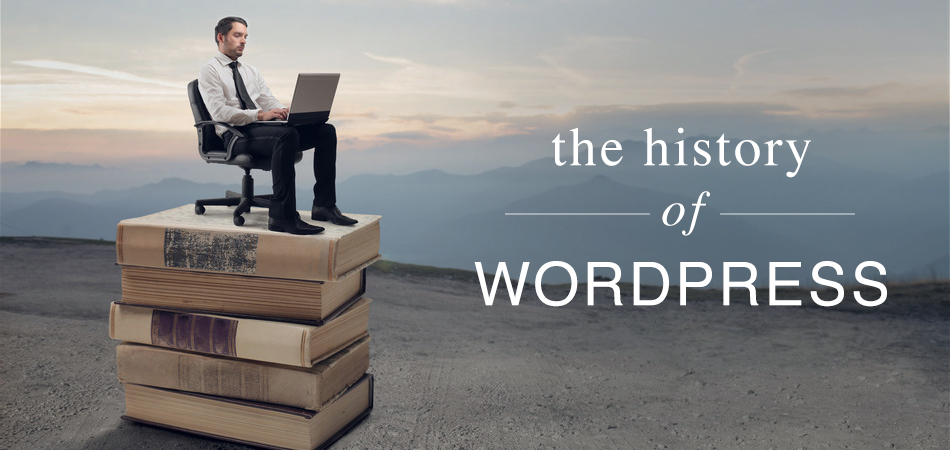
WordPress has been growing steadily over the last couple of years. It looks like nothing it was about ten (13) years ago. The platform is still growing and to catch a glimpse of how it all started, I would like to draw your attention to the History of WordPress: The Good, the Bad and the Ugly.
In today’s post, we will look at how much the WordPress UI (user interface) has evolved since May 27, 2003 when Matt Mullenweg released WordPress 0.7 “Gold”. Before we serve the juice though, let’s backtrack to April 6, 2003, the day he (Matt) invited the entire world in on the fun.
Here is an excerpt from the WordPress blog:
Welcome to the WordPress development blog. Run by WordPress itself, it will catalog what’s happening with the development. Think of it like a changelog with comments, permalinks, archive… – Matt Mullenweg
That was posted in April the 6th and Matt kept updating the blog through May 27th (the official launch date of WordPress 0.7) to this date.
Between April 6, 2003 and May 27 the same year, Matt made updates to various features including comments, styles as well as resolved some validation errors among other things. Everything was going on well, or according to plan. On May 22, 2003, Mullenweg was So Close. May 27, 2003 finally came, which leads us to the first part of this post.
May 27, 2003 – WordPress 0.7 “Gold”
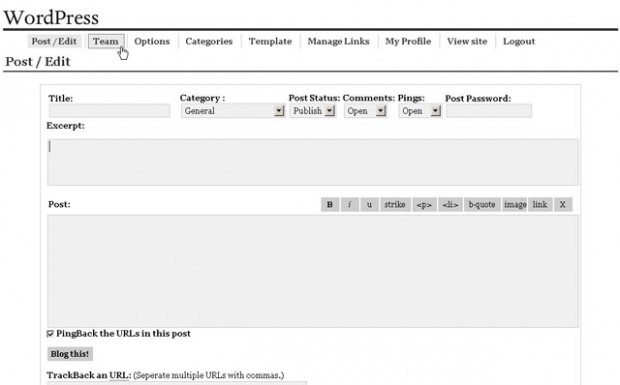
From the photo above, you can see the “dashboard” didn’t look like anything you’ve seen in recent years. In fact, it wasn’t much of a dashboard since you went straight to the post page once logged in.
We can argue the WordPress UI back then focused on simplicity. We can go a step further and excuse the aesthetics since WordPress offered limited functionality. For instance, you could not assign multiple categories to a single post, something we don’t give much thought nowadays. You could not tag or even preview your posts! How times have changed.
All the same, there were a few interesting features that made WordPress 0.7 exciting even without all the AJAX and color we love so much today. For starters, even at this early stage, WordPress was compliant with XHTML standards up to 1.1. Remember Matt’s main “design principle” was to build an easy-to-use blogging platform based on strict web standards. He managed to throw in some CSS into 0.7 even though the results were not as pronounced.
With WordPress 0.7, users had the opportunity to write manual excerpts – summaries of their posts – to appear in RSS feeds among other places, and that was cool. In addition, you could publish your post immediately, save as draft or keep it private.
Updates:
After every major release, Matt and the team behind WordPress release follow-up updates. Some of these updates are important maintenance or security releases while others are beta packages meant for testing purposes (meaning they’re dangerous for your production website). Therefore, after WordPress 0.7, Matt and company released the following updates:
- June 6, 2003 – WordPress 0.71 Beta and WordPress 0.71 Beta 3
- June 9, 2003 – WordPress 0.71 – This came with a lot of bug fixes and other improvements
- June 25, 2003 – WordPress 0.7.1.1
- July 31, 2003 – Link Manager changes were implemented
- Aug 24, 2003 – Point 72 Beta 1 marked the end of manually editing the configuration (wp-config.php) file
- Sept 1, 2003 – Point 72 Beta 2 was introduced to take care of some bugs including the dreaded convert_char problem
- October 4, 2003 – WordPress 0.72 Release Candidate 1 dropped and came with a lot of security fixes
- October 11, 2003 – WordPress 0.72 Final Version that came with a host of new features
January 3, 2004 – WordPress 1.0
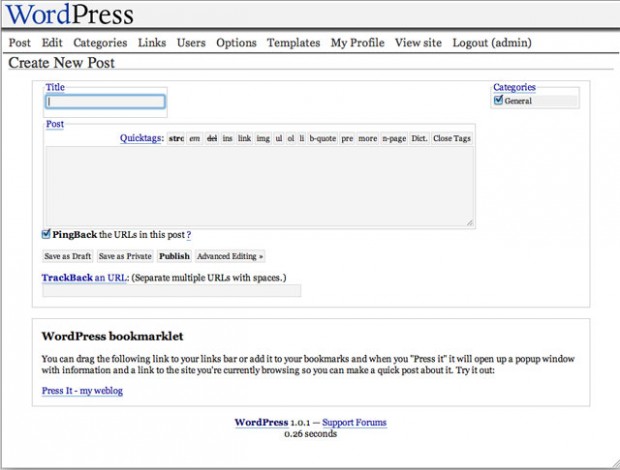
While this was a major step for the WordPress project, it’s surprising to see this release wasn’t named after a jazz legend. All the same, this new version of WordPress came with a couple of awesome features such as a simplified installation process, multiple categories per post, minor improvements to the UI, search engine friendly permalinks, comment moderation and much more. WordPress was heading somewhere, or rather in the right direction albeit slowly.
Updates:
As usual, Matt followed WordPress 1.0 with some important updates (and a major release)
- January 15, 2004 – WordPress 1.0.1 Release Candidate
- January 25, 2004 – WordPress 1.0.1 “Miles” Release
WordPress 1.0.1 “Miles” Release came with a slightly improved UI and significant changes to the codebase. This is how it looked:
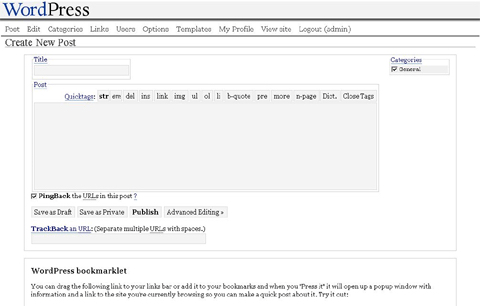
- March 11, 2004 – WordPress Updates. Dougal Campbell revealed “…the team has been working hard behind the scenes…” and “Matt is hoping that we can release 1.2 real soon…”. Eleven days later on March 22, 2004, Matt fixed the download link and made some noise about it on the blog.
- April 29, 2004 – WordPress 1.2 Beta
- May 11, 2004 – Peter Westwood created a WordPress fork for the Gentoo Linux system
- May 14, 2004 – 1.2 Release Candidate
- May 20, 2004 – Final Release Candidate (1.2)
May 22, 2004 – WordPress 1.2 “Mingus”
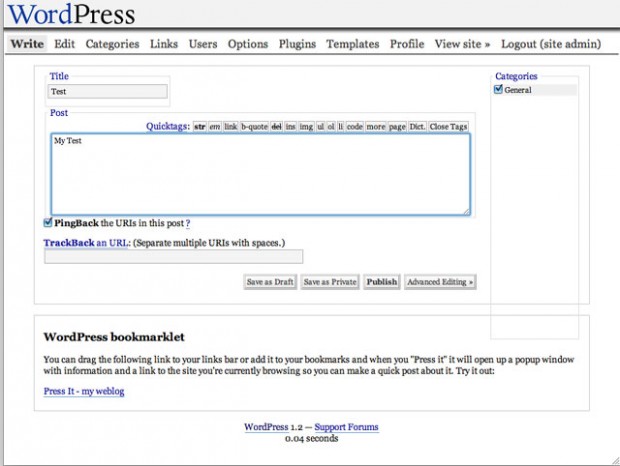
On the night of April 29, 2004, Matt started testing WordPress 1.2, which had been under development since January the same year. Named “Mingus”, WordPress 1.2 dropped three weeks later on May 22, 2004. This much-anticipated version of WordPress did not disappoint in the features department for it came with the plugin architecture to extend WordPress easily, improved security; encrypted passwords and the works, unlimited update service, post preview, automatic thumbnail creator, sub categories, et cetera.
Updates:
- October 6, 2004 – WordPress 1.2.1
- December 15, 2004 – WordPress 1.2.2
February 17, 2005 – WordPress 1.5 “Strayhorn”
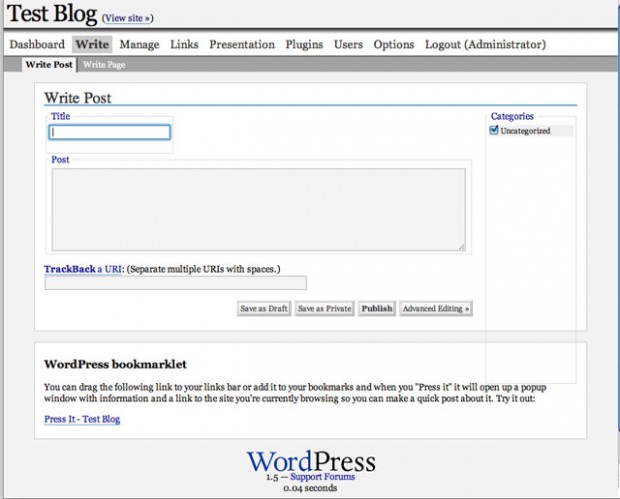
Power and elegance defined WordPress 1.5, named “Strayhorn” after Billy Strayhorn, the jazz pianist and sublime composer. As Gwen Stefani was trying to recover her stolen red dress, WordPress 1.5 was registering its 12,000th download. What changed in one point five?
A flexible theme system became a reality, the comment system improved in leaps and bounds, pages were introduced so you can build websites and the Dashboard feature made a debut among other things.
Updates:
Three updates followed “Strayhorn” later in the year:
- May 9, 2005 – WordPress 1.5.1 (Updated) – by now, WordPress 1.5 had over 200,000 downloads
- June 29, 2005 – WordPress 1.5.1.3 – Matt advised WordPress users to delete some file named xmlrpc.php if they were unable to upgrade in the short-term
- August 14, 2005 – WordPress 1.5.2 – Security fixes
- December 20, 2005 – WordPress 2.0 Release Candidate – Can you smell WordPress 2.0 cooking? Ryan Boren announced this release.
December 31, 2005 – WordPress 2.0 “Duke”
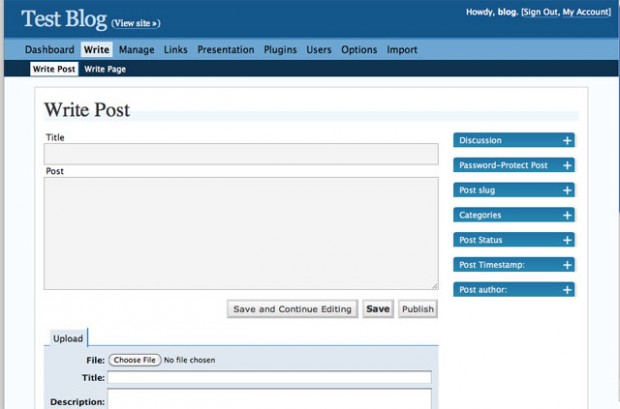
On New Year’s Eve, the WordPress team presented the second generation of WordPress to the world, and with it came a completely designed back-end among other cool features including:
- The visual editor (WYSIWYG)
- The UI team gave WordPress a facelift with a blue design
- Comments would fade out after deletion thanks to AJAX technology
- Inline uploads were introduced
- Akismet was bundled in this version
- User roles were invented
WordPress 2.0 had a few surprises for developers as well. The release came with great developer-friendly features such as built-in caching, theme screenshots, theme functions (functions.php), advanced abstraction and plenty of plugin hooks among others. Major “bugicide” took place at this time as well.
Updates:
- January 31, 2006 – 2.0.1 Release – This came exactly one month later and fixed over 100 bugs among other problems
- March 10, 2006 – 2.0.2 Security Release
- April 1, 2006 – WordPattern (Aprils Fools) – WordPattern was/is a joke!
- June 1, 2006 – WordPress 2.0.3
- July 29, 2006 – WordPress 2.0.4
- October 23, 2006 – MU 1.0 and bbPress
- October 27, 2006 – WordPress 2.0.5 “Ronan” thanks to Ryan Boren (This release was not named after any jazz legend)
- January 5, 2007 – WordPress 2.0.6
- January 15, 2007 – WordPress 2.0.7
January 22, 2007 – WordPress 2.1 “Ella”
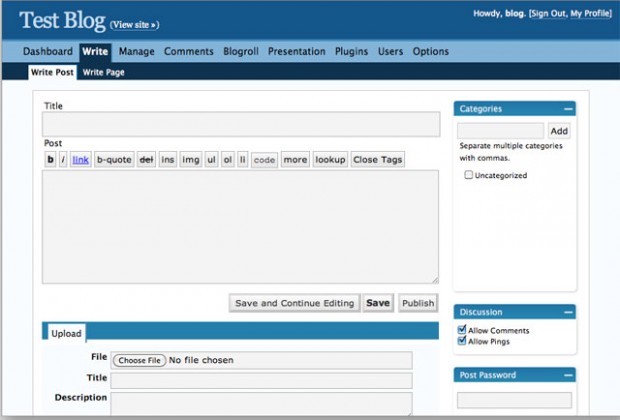
On behalf of the WordPress.org community, Matt proudly announced the availability of another release, a WordPress 2.1 aka “Ella” in honor of Ella Fitzgerald, a super talented jazz vocalist. If you have a thing for jazz music, play some of her music right now 🙂 .
The UI improved slightly even though a good number of new features were introduced. More AJAX was thrown into the admin panel to improve appearance and performance. Other features included a new version of Akismet, search engine privacy, autosave, spell checker, XML import/export and a redesigned post editor among others.
In a blog post published on the WordPress blog on this day, Matt predicted the future by announcing the next version of WordPress would drop on April 23, 2007. This was not to be the case as WordPress 2.2 “Getz” came on May 16, 2007 due to a change in the development cycle.
Updates:
- April 3, 2007 – WordPress 2.1.3 and 2.0.10
May 16, 2007 – WordPress 2.2 “Getz”
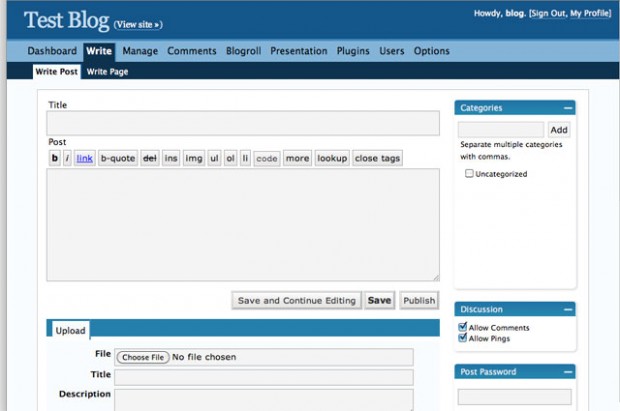
On this day, Matt released WordPress 2.2 “Getz” for tenor saxophonist Stan Getz. Just like version 2.2, WordPress 2.2 UI didn’t change much although it came with a horde of new features such as the widget system, blogger importer, infinite comment system, full atom support and jQuery among other features. This release fixed over 240 bugs and came with a couple of developer features not mentioned above.
Updates:
- June 21, 2007 – WordPress 2.2.1
- August 2, 2007 – WordPress 2.2.2 and 2.0.11
- September 8, 2007 – WordPress 2.2.3
- September 11, 2007 – WordPress 2.3 Beta 3
- September 19, 2007 – WordPress 2.3 Release Candidate
September 25, 2007 – WordPress 2.3 “Dexter”
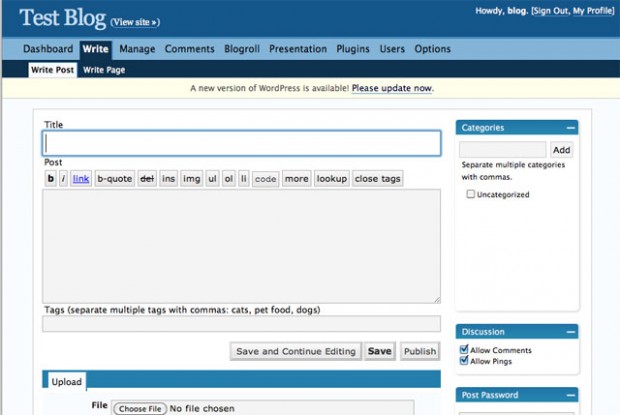
The UI hadn’t changed much since WordPress 2.1 but this release fixed a lot of security loopholes. Other than that, “Dexter” came with these among other features: native tagging support so you can add tags to your posts, the nagging update notification, canonical URLs, kitchen sink button and the pending review feature.
People held parties around the world to celebrate WordPress 2.3. Rumor has it that there was one such party in San Francisco that had Matt in attendance but that’s story for another day. With all the new features and constant improvements, WordPress was gaining traction and becoming more popular by the day.
Updates:
- October 24, 2007 – WordPress 2.3.1. Release Candidate 1
- October 26, 2007 – WordPress 2.3.1
- December 29, 2007 – WordPress 2.3.2
March 29, 2008 – WordPress 2.5 “Brecker”
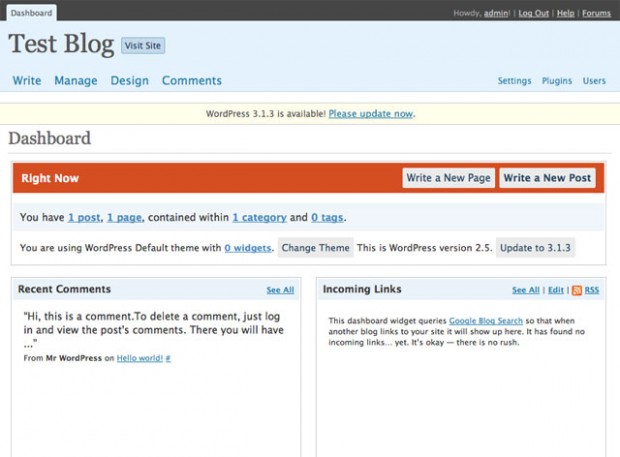
After six (6) months of hard work, WordPress 2.5 was ready for the unveiling ceremony. And it came with a motherload of improved and new features, the kind that would need “…a cup of coffee or a mojito…” to go through.
Features at a glance:
- We saw the entry of beautiful Dashboard widgets
- Multi-file uploader
- Password strength indicator
- Built-in galleries
- Shortcode API
The Post Editor:
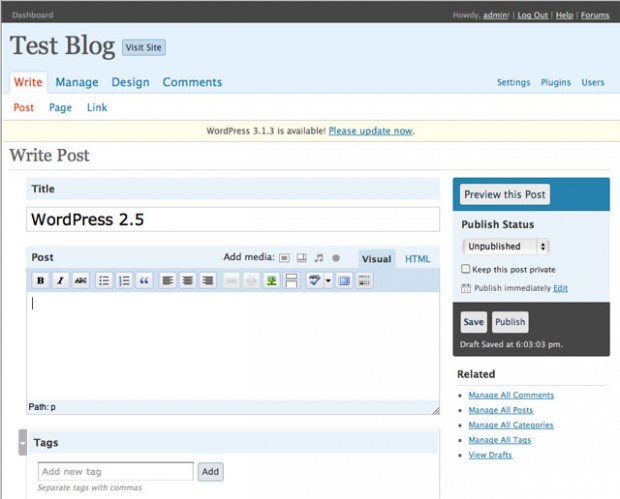
The post editor in this version was starkly different from previous versions, and critics had a field day with this. The dashboard UI looked a lot better. It was less cluttered and utilized a relaxed color scheme.
Update:
Only one update this time.
- April 25, 2008 – WordPress 2.5.1 – A number of bug fixes. Announcement made by Royen Boren
July 15, 2008 – WordPress 2.6 “Tyner”
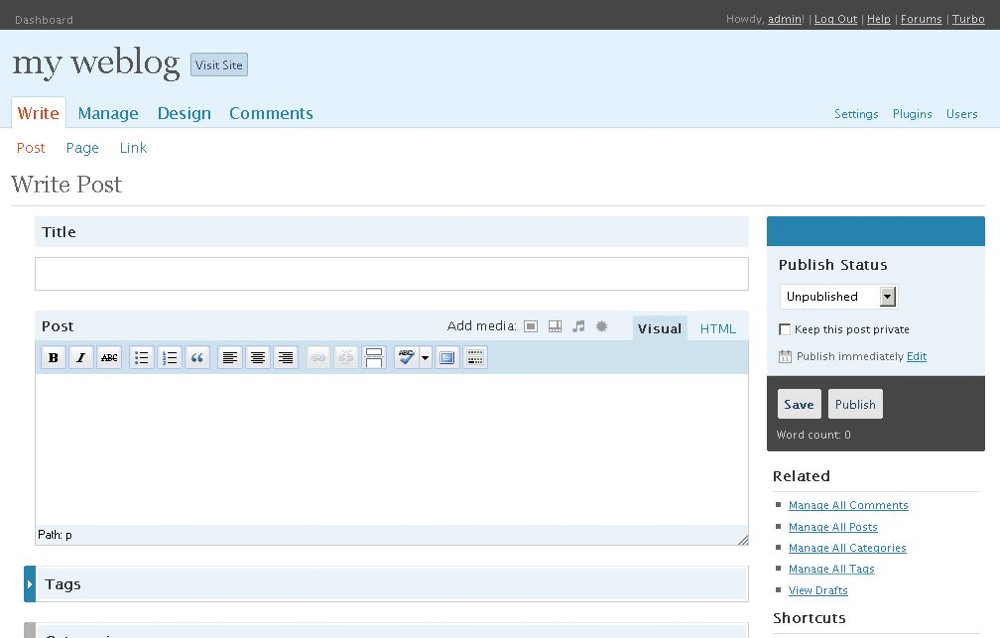
WordPress 2.6 “Tyner”, named after jazz pianist McCoy Tyner came almost a month ahead schedule. With pages in place and a plethora of features at your disposal, WordPress was quickly morphing from a blogging platform to a fully fledged CMS (Content Management System).
This version of WordPress saw the introduction of many useful features including post revisions, Press This!, image captions, word count, plugin update notification and bulk management of plugins among others. Just like the previous major releases, “Tyner” got its share of updates.
Updates:
- August 15, 2008 – WordPress 2.6.1 – Bug fixes, improvements for international users
- September 8, 2008 – WordPress 2.6.2
- October 23, 2008 – WordPress 2.6.3 – Bug in the Snoopy library was fixed
December 11, 2008 – WordPress 2.7 “Coltrane”
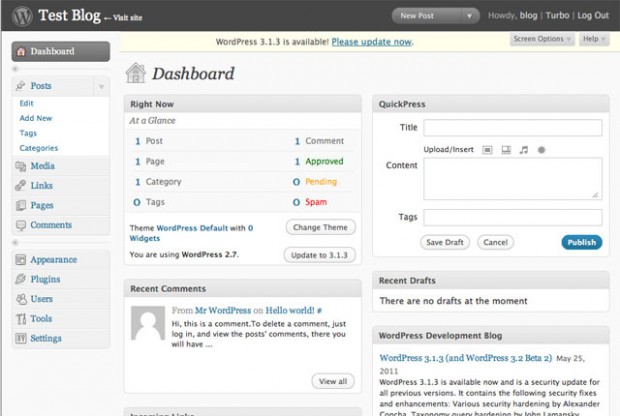
WordPress 2.7 ushered in a new era in terms of UI and features. The Dashboard had more resources and the left menu was added to aid navigation. You could move around easily and achieve more in a shorter period than ever before. WordPress 2.7 “Coltrane” is heavily documented. It’s probably the most heavily documented of all versions. This has everything to do with the new design and the host of features that came with it.
For instance, you could arrange dashboard widgets with drag and drop simplicity. You could reply to comments from your dashboard and install plugins straight from the WordPress plugin repository without leaving your site. Screen Options feature was introduced to help users to customize each screen.
The Post Editor:
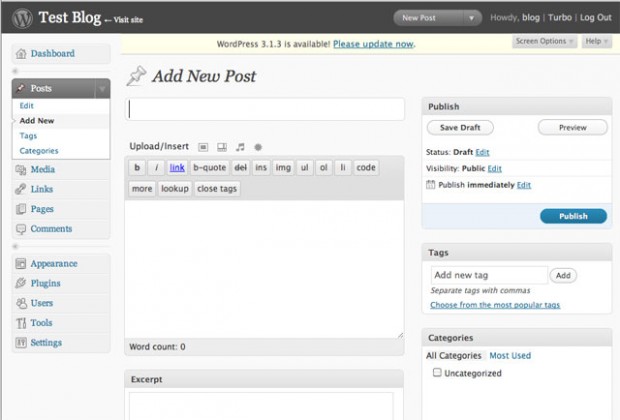
Updates:
- February 10, 2009 – WordPress 2.7.1
June 11, 2009 – WordPress 2.8 “Baker”
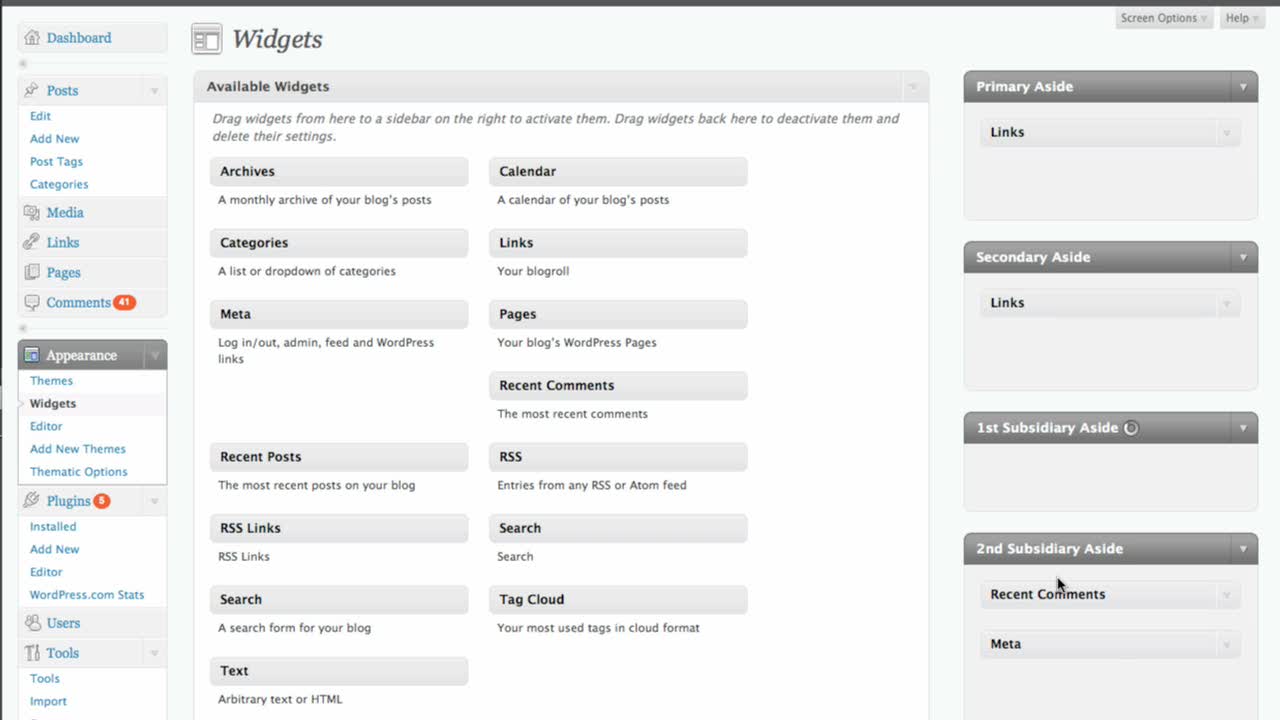
In a post titled “2.8 Release Jazzes Themes and Widgets“, Matt said, “2.8 represents a nice fit and finish release for WordPress with improvements to themes, widgets, taxonomies and overall speed.” In addition, the release came with improved admin icons, new Screen Options and a long-deprecated feature known as Turbo among others. But even with these changes and improvements to the widget and theme systems, very little changed in terms of UI.
Updates:
- July 9, 20009 – WordPress 2.8.1
- July 20, 2009 – WordPress 2.8.2
- August 3, 2009 – WordPress 2.8.3 Security Release
- August 12, 2009 – WordPRess 2.8.4 Security Release
- October 20, 2009 – WordPress 2.8.5 Hardening Release
- November 12, 2009 – WordPRess 2.8.6 Security Release
December 19, 2009 – WordPress 2.9 “Carmen”
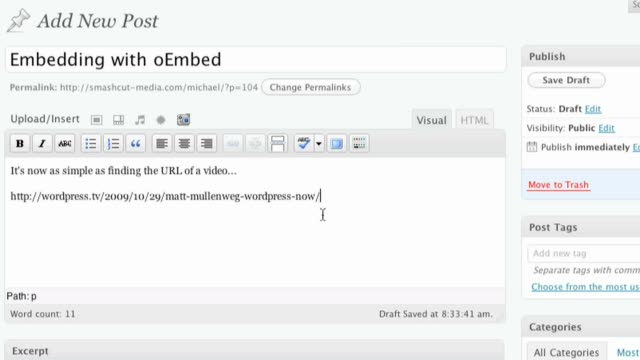
In terms of user interface, there were insignificant changes (if any). However, just like any major release, WordPress 2.9 came with a couple of great features such as super-easy video embeds, built-in image editor, better SEO, automatic database optimization. You could also bring deleted posts back from the “grave” with the undo/”trash” feature.
By the way, you can enable automatic database optimization by adding the following code to your wp-config.php file:
define ('WP_ALLOW_REPAIR',true);
Updates:
- January 4, 2010 – WordPress 2.9.1
- February 15, 2010 – WordPress 2.9.2
June 17, 2010 – WordPress 3.0 “Thelonious”
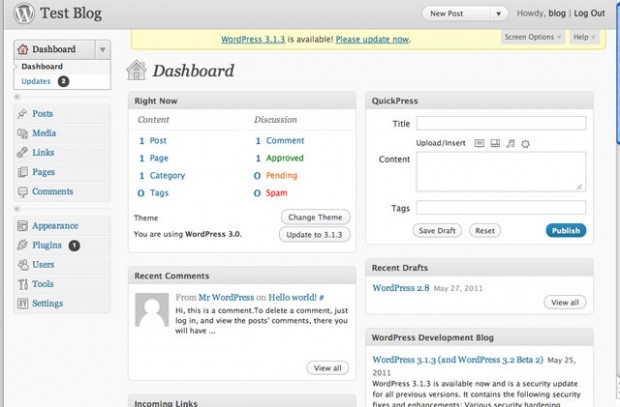
The thirteenth (13th) major release of WordPress came nearly half a year later. Named “Thelonious”, WordPress 3.0 was the combined effort of more than two hundred (200) contributors. The UI looked great and the team had even more features for the world. This release fixed over 1,200 bugs and brought a couple of nice features such as:
- Default theme named Twenty Ten
- Custom headers and backgrounds
- Shortlinks
- Menus
- Custom post types
- Merge of WordPress and MU
- Et cetera
At around the same time, Matt laid out the philosophy guiding WordPress in a speech he gave at WordCamp San Francisco.
The Post Editor:
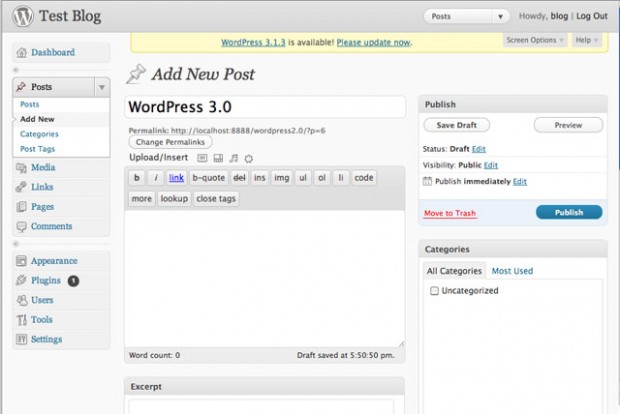
Updates:
After Thelonious, we saw plenty of minor updates some of which were made for mobile devices. WordPress was finally going mobile!
- July 29, 2010 – WordPress 3.0.1
- September 30, 2010 – WordPress for iPhone/iPad v2.6 Released
- November 25, 2010 – Android Update 1.3.8, WordPress 3.1 Beta 1
- November 30, 2010 – WordPress 3.0.2
- December 8, 2010 – WordPress 3.0.3
- December 15, 2010 – WordPress 3.1 Beta 2
- December 25, 2010 – 3.0.4 Important Security Update
- January 1, 2011 – WordPress 3.1 Release Candidate 2
- January 22, 2011 – WordPress 3.1 Release Candidate 3
- February 7, 2011 – WordPress 3.0.5 (and 3.1 Release)
February 23, 2011 – WordPress 3.1 Reinhardt”
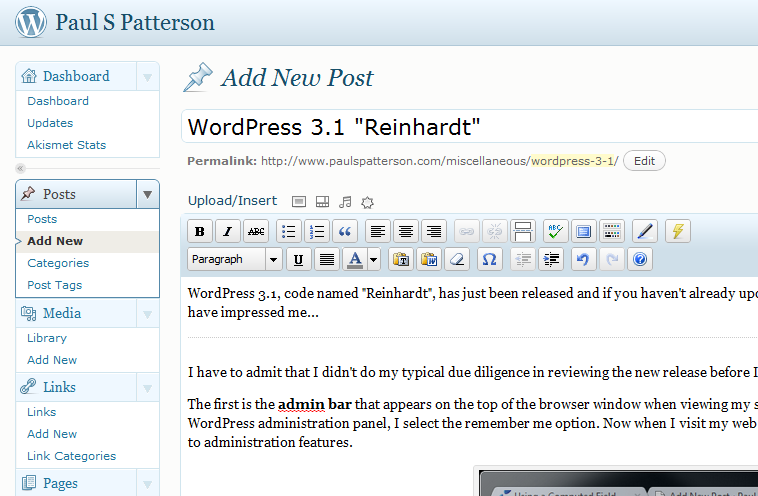
After releasing WordPress 3.1, Matt declared, “…WordPress is more of a CMS than ever before. The only limit to what you can build is your imagination.” The public started seeing the potential of WordPress as a CMS at about this time.
To help you achieve your online publishing dreams, 3.1 shipped with a couple of cool features such as a streamlined post editor, improved linking workflow so you can link to older content and the Admin bar among other features. Over 2k commits went into the making of WordPress 3.1. It was an exciting time I tell you.
Updates:
- April 26, 2011 – WordPress 3.1.2
- May 12, 2011 – WordPress 3.2 Beta 1
- May 25, 2011 – WordPress (and WordPress 3.2 Beta 2)
- June 14, 2011 – WordPress 3.2 Release Candidate
- June 29, 2011 WordPress 3.1.4 (and 3.2 Release Candidate 3)
May 12, 2011 – WordPress 3.2 Beta 1
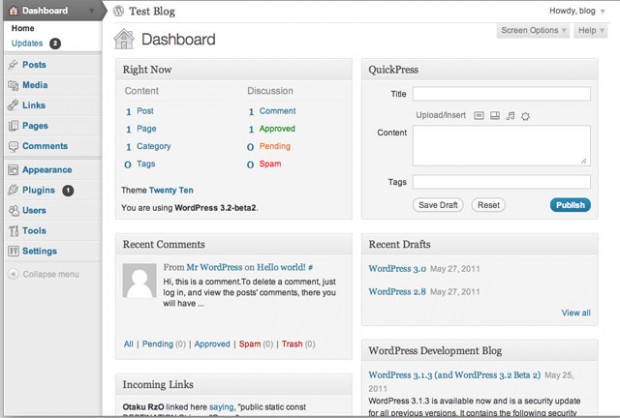
Three months later, WordPress 3.2 Beta 1 was born. What was new? There was a major Admin UI refresh (the last redesign had been in 2008), the Twenty Eleven theme was introduced, the admin bar got more links and distraction-free writing mode was created to help you focus on your content. A warning was sounded; “…we don’t recommend that you run it on a production site…” but in terms of UI, 3.2 Beta 1 had so much more to offer than 3.1.
Updates:
- WordPress 3.1 (and WordPress 3.2 Beta 2)
- WordPress 3.2 Release Candidate
- WordPress 3.1.4 (and 3.2 Release Candidate)
July 4, 2011 – WordPress 3.2 “Gershwin”
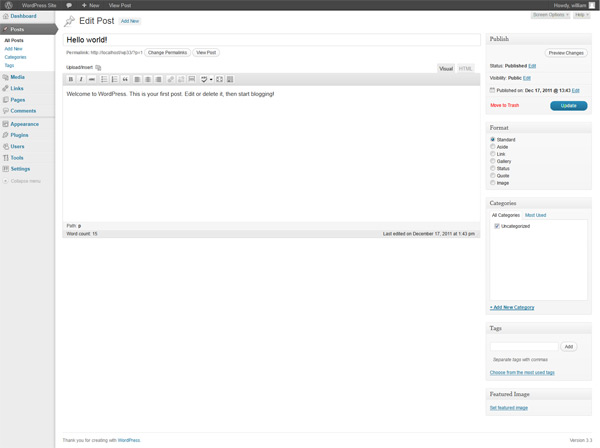
On Independence Day, 2011, WordPress 3.2 “Gershwin”, the fifteenth major release was available to the world. As if by coincidence, WordPress 3.1 passed the 15 million download mark on the same day. The faster and lighter WordPress 3.2 came with a new HTML5 Twenty Eleven theme, Zen mode so you can write without distractions, a redesigned WordPress UI, a generous thank you note and so much more.
Updates
[Jack Bauer’s voice] The following happened between WordPress 3.2 and WordPress 3.3. Matt and team released the following updates:
- July 12, 2011 – WordPress 3.2.1
- October 11, 2011 – WordPress 3.3 Beta 1
- October 20, 2011 – WordPress 3.3 Beta 2
- November 8, 2011 – WordPress 3.3 Beta 3
- November 24, 2011 – WordPress 3.3 Beta 4
- December 1, 2011 – WordPress 3.3 Release Candidate
- December 7, 2011 – WordPress 3.3 Release Candidate 2
- December 11, 2011 – WordPress 3.3 Release Candidate 3
December 12, 2011 – WordPress 3.3 “Sonny”
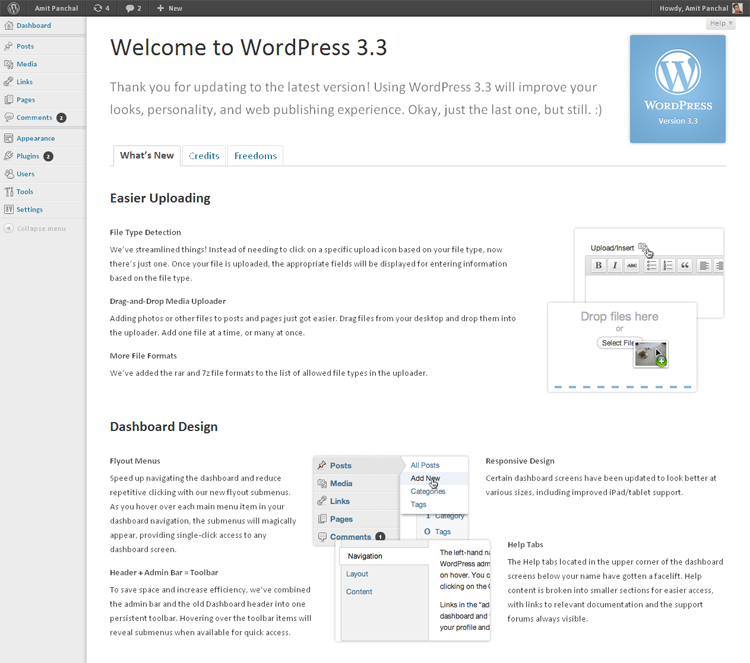
Considered the latest and greatest version of WordPress at that time, WordPress 3.3 “Sonny” for Sonny Stitt – jazz saxophonist – came at a time when WordPress had over 65 million downloads. Oh yeah, WordPress had grown big. Some new features includes a new toolbar, drag-and-drop uploader, improved dashboard UI on iPad and other tablets, pointer tips for new features etc.
Updates:
- January 3, 2012 – WordPress 3.3.1 Security and Maintenance Release
- April 5, 2012 – WordPress 3.4 Beta 1
- April 12, 2012 – WordPress 3.4 Beta 2
- April 20, 2012 – WordPress 3.4 Beta 3 (and WordPress 3.3.2)
- May 3, 2012 – WordPress 3.4 Beta 4
- May 26, 2012 – WordPress 3.4 Release Candidate
- June 7, 2012 – WordPress 3.4 Release Candidate 2
June 13, 2012 – WordPress 3.4 “Green”
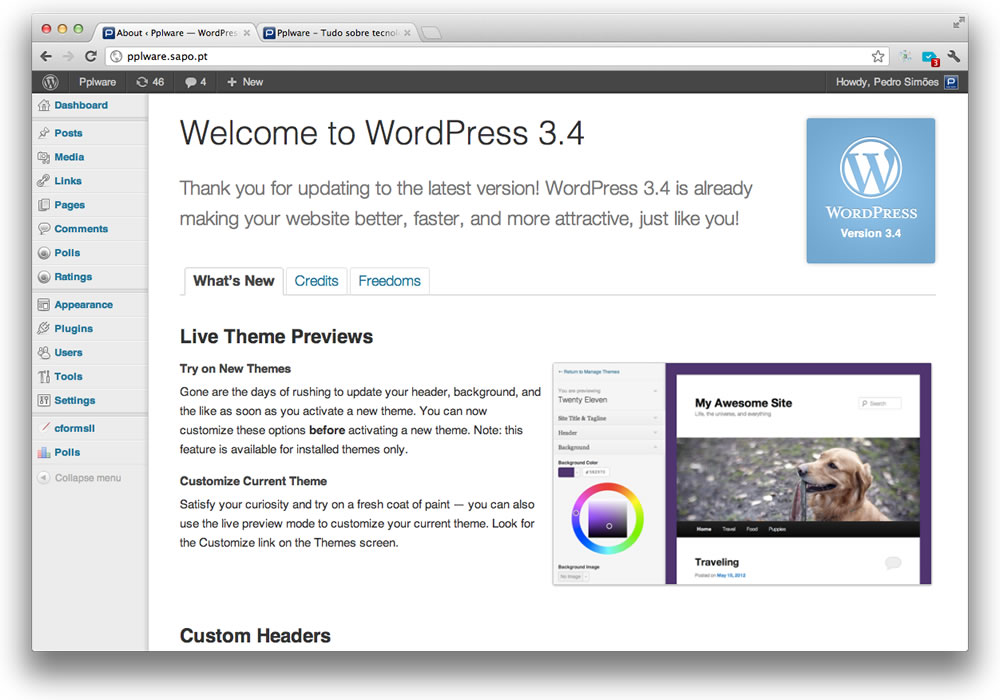
On the second week of June, 2012, the world welcomed WordPress 3.4 codenamed “Green” after jazz guitarist Grant Green. The release came with significant improvements to the theme system, Twitter embeds, custom headers and improved image captions (you could add HTML).
Updates:
- June 27, 2012 – WordPress 3.4.1 Maintenance and Security Release
- September 6, 2012 – WordPress 3.4.2 Maintenance and Security Release
- September 27, 2012 – WordPress Beta 1
- October 13, 2012 – WordPress 3.5 Beta 2
- November 13, 2012 – WordPress 3.5 Beta 3
December 11, 2012 – WordPress 3.5 “Elvin”
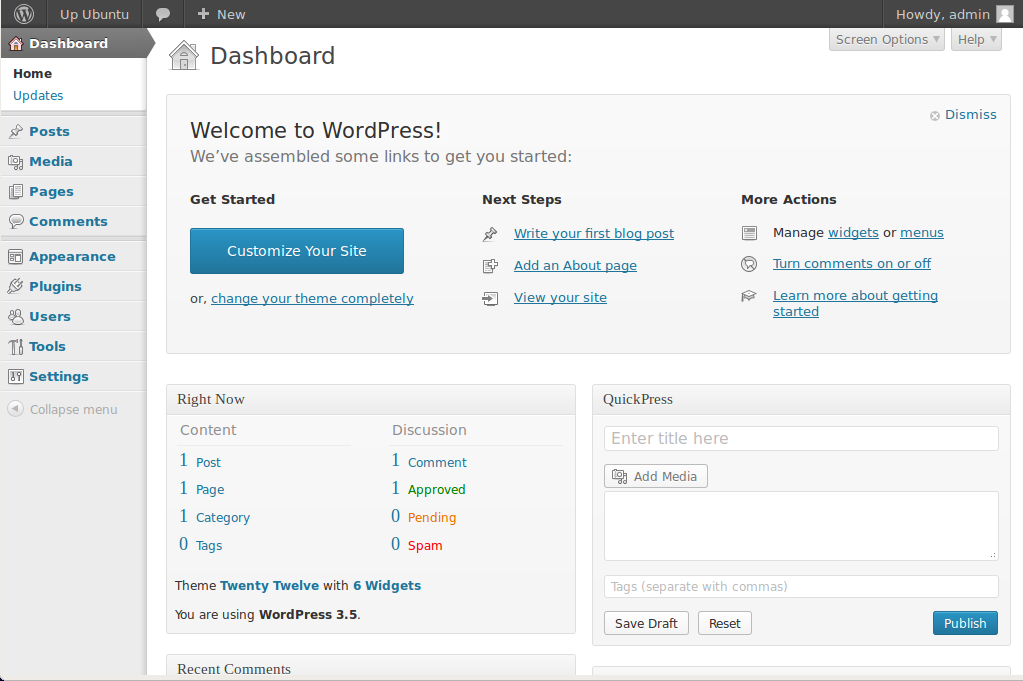
Development was picking up momentum as more contributors joined Matt. WordPress 3.5, named “Elvin” in honor of Elvin Jones the drummer was “…chock-full of goodies to delight bloggers and developers alike.” For instance, the media manager was redesigned to give you more control over your media, Twenty Twelve was released and tweaks were made to the UI making it retina-ready among other things.
Updates:
- January 14, 2013 – WordPress 3.5.1 Maintenance and Security Release
- April 4, 2012 – WordPress 3.6 Beta 1
- June 21, 2013 – WordPress 3.5.2 Maintenance and Security Release
August 1, 2013 – WordPress 3.6 “Oscar”
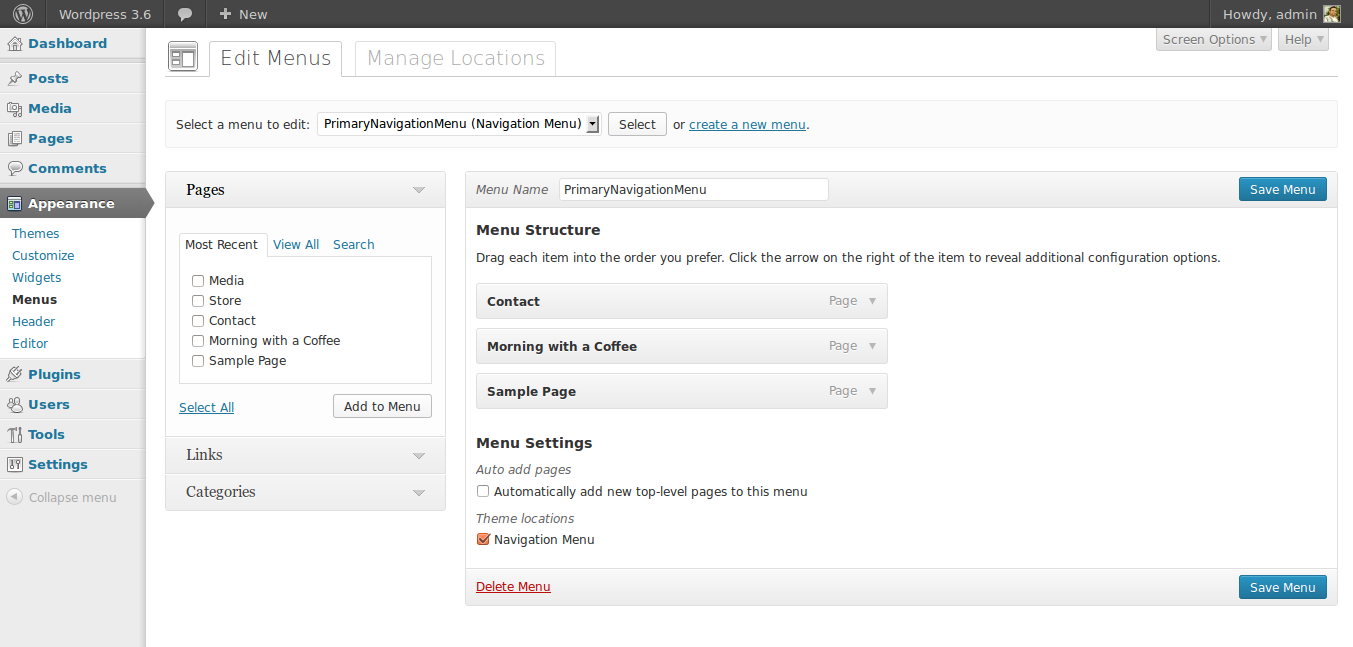
Out of the box, WordPress 3.6 “Oscar” user interface looked great. With the improved UI came other great features such as an intuitive autosave, post locking, Twenty Thirteen theme, audio and video embeds thanks to a built-in HTML media player and improved menu editor among other things.
Updates:
- September 11, 2013 – WordPress 3.6.1 Maintenance and Security Release
- September 28, 2013 – WordPress 3.7 Beta 1
- October 10, 2013 – WordPress 3.7 Beta 2
- October 18, 2013 – WordPress 3.7 Release Candidate
- October 23, 2013 – WordPress 3.7 Release Candidate 2
October 24, 2013 – WordPress 3.7 “Basie”
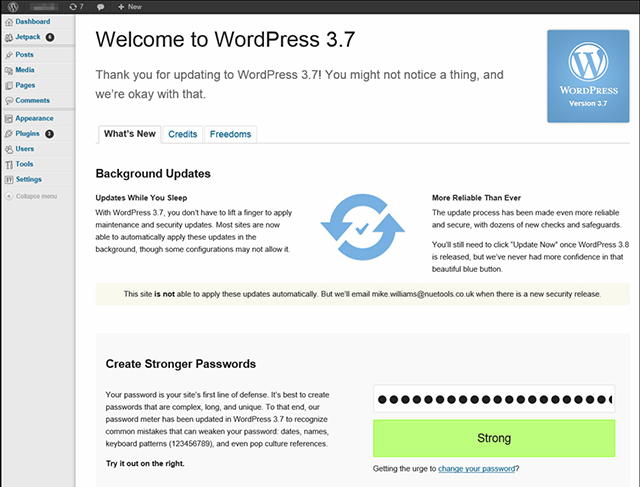
Named after Count Basie, WordPress 3.7 came with great and useful architectural updates. It was the first release of plugin-led development, a design approach the WordPress community adopted after WordPress 3.6. Great features that came with 3.7 included automatic updates, stronger passwords, better global support and a host of developer features.
After the complimentary thank you note, Matt added, “Enjoy what may be one of your last few manual updates…” and so it became. Basie admin UI looked better than before.
Updates:
- October 29, 2013 – WordPress 3.7.1 Maintenance Release
- November 21, 2013 – WordPress 3.8 Beta 1
- December 4, 2013 – WordPress 3.8 RC1
- December 10, 2013 – WordPress 3.8 RC2
December 12, 2013 – WordPress 3.8 “Parker”
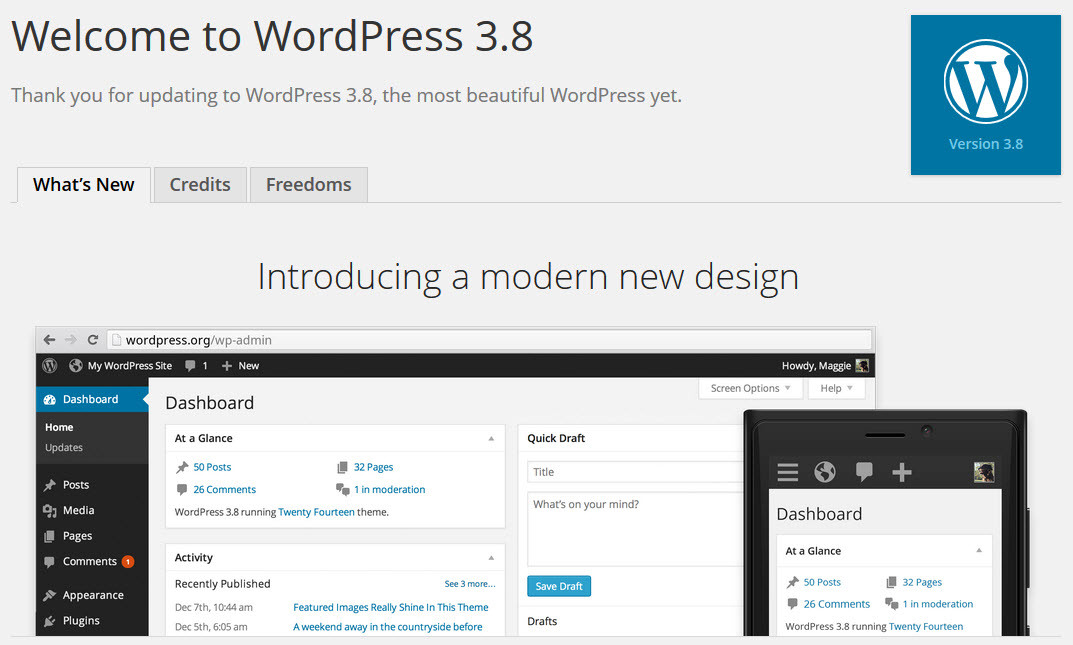
Charlie Parker, bebop innovator, was the person WordPress 3.8 was named after. This release came with a modern new design that was breathtaking but still managed to focus on “clarity and simplicity.” The design was colorful with cleaner typography and refined contrasts. WordPress 3.8 was responsive, and as a result looked great on any mobile device.
WordPress was not only powerful, but also beautiful what with eight (8) admin color schemes to choose from. The WordPress community made additional improvements to the theme system, brought better widgets and the Twenty Fourteen theme. It was all glory.
Updates that followed:
- January 23, 2014 – WordPress 3.8.1 Maintenance Release
- March 11, 2014 – WordPress 3.9 Beta 1
- March 20, 2014 – WordPress 3.9 beta 2
- March 29, 2014 – WordPress 3.9 Beta 3
- April 8, 2014 – WordPress 3.8.2 Security Release and WordPress 3.9 Release Candidate
- April 14, 2014 – WordPress 3.8.3 Maintenance Release
- April 15, 2014 – WordPress 3.9 Release Candidate
April 16, 2014 – WordPress 3.9 “Smith”
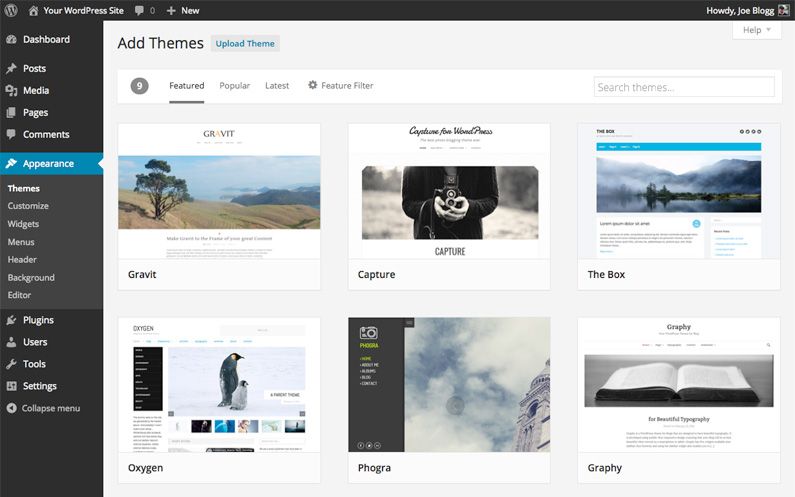
On the 16th day of April 2014, WordPress 3.9 named “Smith” dropped. It was named in honor of jazz organist Jimmy Smith. The user interface looked similar to WordPress 3.8 but there was great improvement and introduction of new features. The image editor was developed, visual editor redesigned, gallery preview added, HTML media player improved and you could edit widgets and headers right in the theme customizer. A new theme browser was also throw in the mix with great result.
On the same day, Matt posted to the WordPress blog thanking over 260 contributors and encouraging more developers to chip in.
Updates:
- May 8, 2014 – WordPress 3.9.1 Maintenance Release
- July 10, 2014 – WordPress 4.0 Beta 1
- July 18, 2014 – WordPress 4.0 Beta 2
- August 6, 2014 – WordPress 3.9.2 Security Release
- August 25, 2014 – WordPress 4.0 Beta 4
- August 27, 2014 – WordPress 4.0 Release Candidate
September 4, 2014 – WordPress 4.0 “Benny”
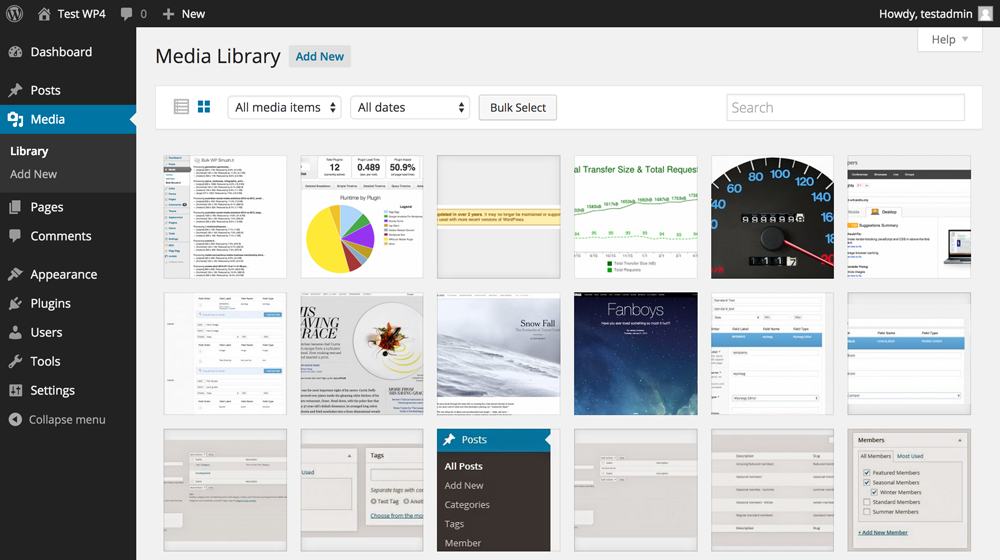
Version 4.0 of WordPress was born on 4th September, 2014 and came with a little extra polish. The main improvement came in the form of “…a smoother writing and management experience…” powered by features such as a redesigned media library, sticky toolbar in the post editor, improved embeds, a new plugin browser and a visual Customizer that is built to maximize productivity. WordPress 4.0 “Benny” is the culmination of more than ten (10) years of determination, ingenuity and hard work. It’s beautiful, powerful and more versatile than ever before.
Updates:
- November 14, 2014 – WordPress 4.1 Beta 1
- November 20, 2014 – WordPress 4.0.1 Security Release
- December 11, 2014 – WordPress 4.1 Release Candidate
- December 18, 2014 – WordPress 4.1 Release Candidate 3
December 18, 2014 – WordPress 4.1 “Dinah”
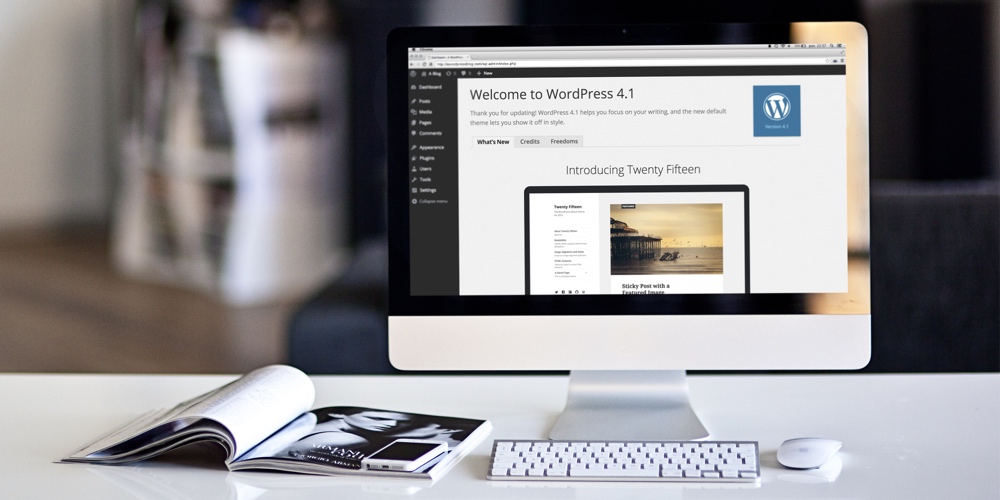
Someone’s in the kitchen with Dinah! Just kidding (but maybe?) – WordPress 4.1 Dinah was released at the end of 2014 and was a smaller update compared to previous releases. Nonetheless it definitely included a few impressive additions to the WordPress framework. The main addition was a clean and easy to use distraction free writing mode allowing users to enter a simplified editor with text fields only. Other notable additions included more language translations, global profile log out, Vine support and recommended plugins.
Updates:
- February 18, 2015 – WordPress 4.1.1 Maintenance Release
- March 12, 2015 – WordPress 4.2 Beta 1
- March 19, 2015 – WordPress 4.2 Beta 2
- March 26, 2015 – WordPress 4.2 Beta 3
- April 3, 2015 – WordPress 4.2 Beta 4
- April 15, 2015 – WordPress 4.2 Release Candidate
- April 21, 2015 – WordPress 4.1.2 Security Release
April 23, 2015 – WordPress 4.2 “Powell”
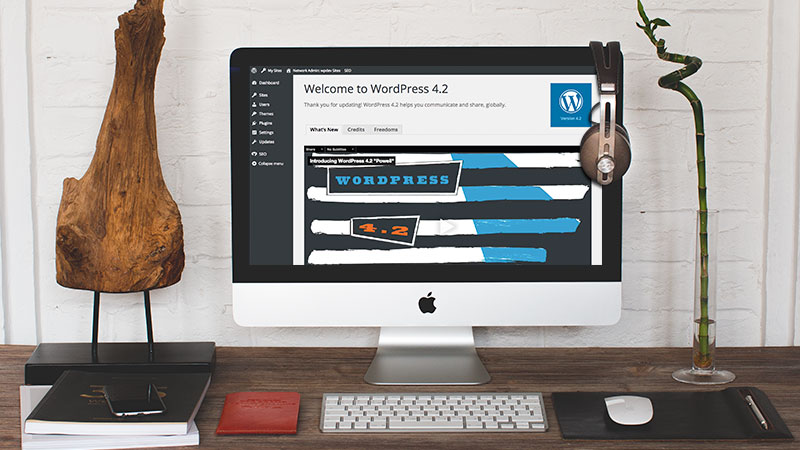
April of 2015 brought us version 4.2 of WordPress and a bunch of brand new awesomeness to enjoy. Updates included support for utf8mb4 characters (like emojis, or more practically languages such as Japanese, Chinese and Korean), improvements to WordPress’ own Press This feature for creating posts from media you fins on the web, and extension to the long list of supported oembeds and even easier plugin updates (right from the plugins screen). But our favorite addition was improvements to the live WOrdPRess Customizer which was revamped to include a Themes section.
Updates:
- April 27 ,2015 – WordPress 4.2.1 Security Release
- May 7, 2015 – WordPress 4.2.2 Security & Maintenance Release
- July 2, 2015 – WordPress 4.3 Beta 1
- July 8, 2015 – WordPress 4.3 Beta 2
- July 15, 2015 – WordPress 4.3 Beta 3
- July 22, 2015 – WordPress 4.3 Beta 4
- July 23, 2015 – WordPress 4.2.3 Security & Maintenance Release
- July 29, 2015 – WordPress 4.3 Release Candidate
- August 4, 2015 – WordPress 4.2.4 Security & Maintenance Release
August 18, 2015 – WordPress 4.3 “Billie”
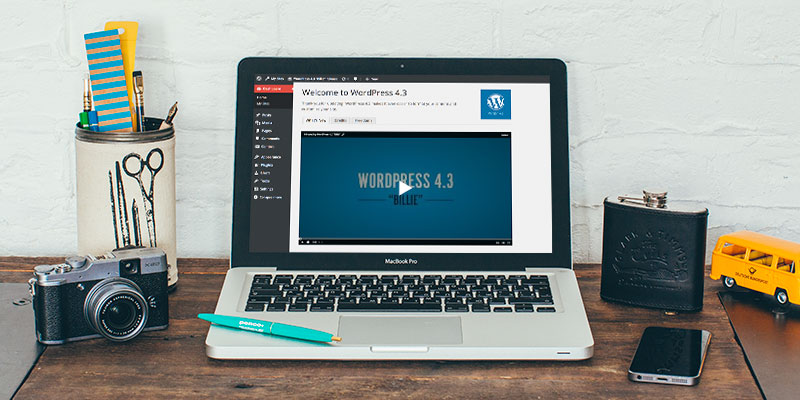
WordPress 4.3 picked up right where 4.2 left off by adding in site icons and menus to the visual Customizer making it easier for users to see what their menus and drop-downs would look like on the front-end. Other updates included strong password enforcement, super easy formatting shortcuts (just use # for headings or * for bulleted lists among others) and an easy one click edit link on live posts that you want to make quick changes to.
Updates:
- September 15, 2015 – WordPress 4.3.1 Security & Maintenance Release
- October 22, 2015 – WordPress 4.4 Beta 1
- October 28, 2015 – WordPress 4.4 Beta 2
- November 4, 2015 – WordPress 4.4 Beta 3
- November 12, 2015 – WordPress 4.4 Beta 4
- November 25, 2015 – WordPress 4.4 Release Candidate
December 8, 2015 – WordPress 4.4 “Clifford”
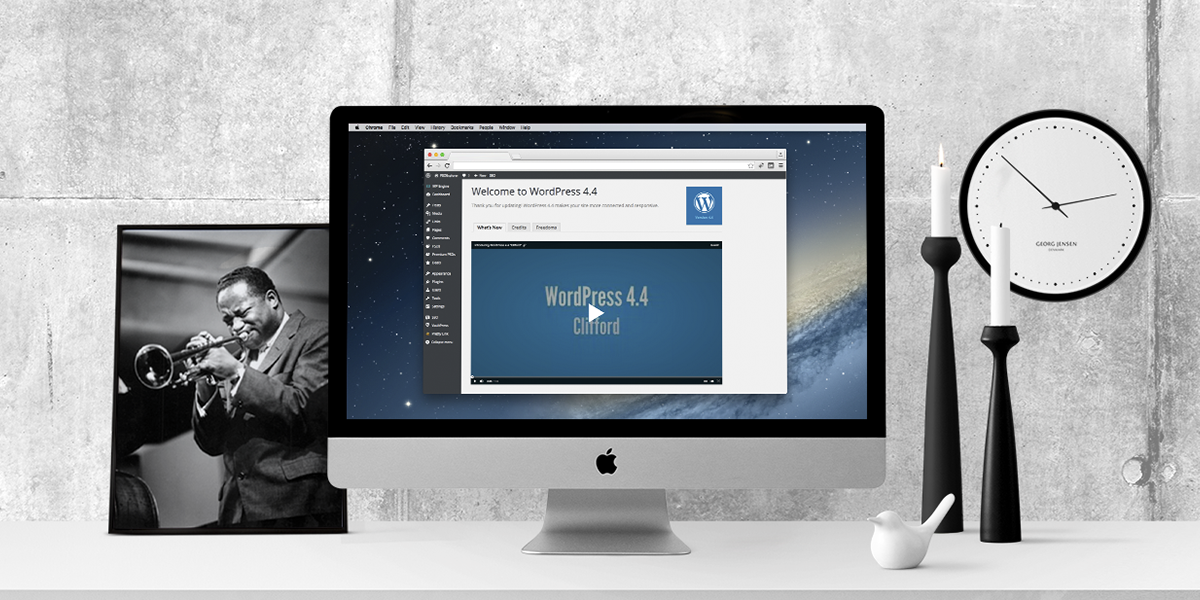
WordPress wrapped up 2015 with version 4.4 code named Clifford full of tons of cool options for every WordPress user. First of all they added the option to embed any URL into your posts – just paste in a link to display a card snippet similar to Twitter and Facebook.
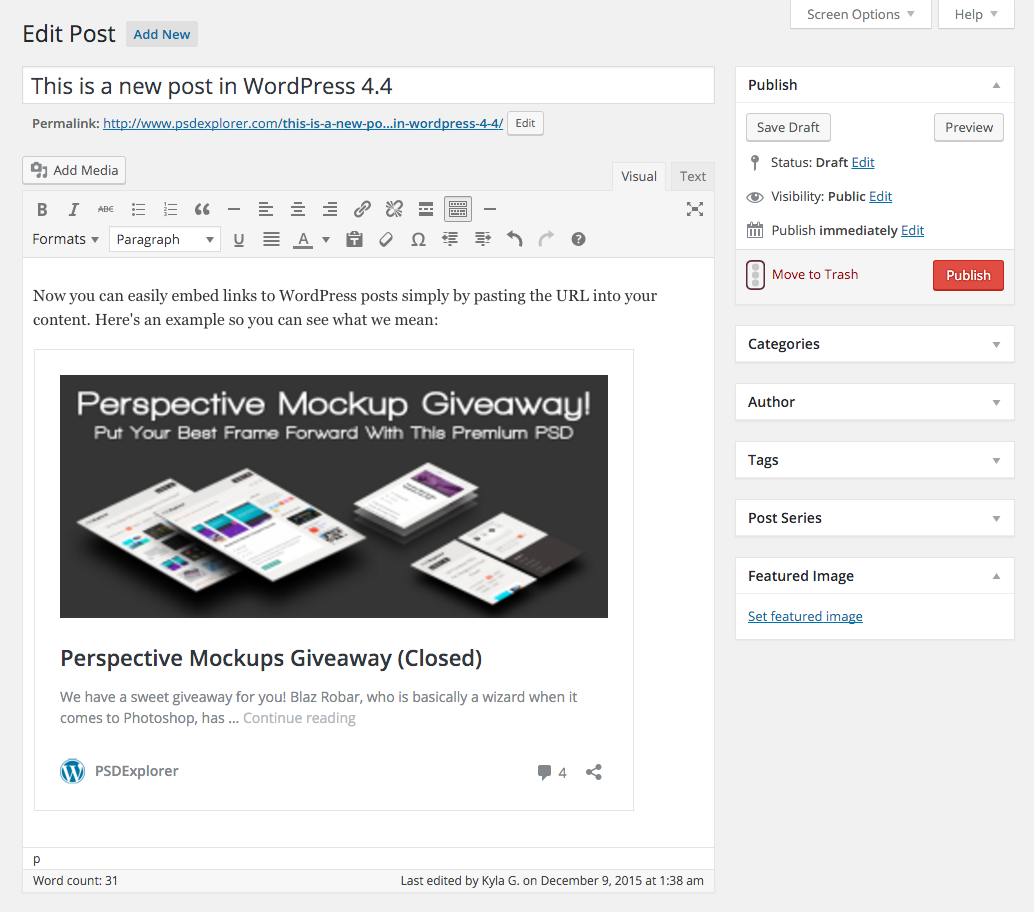
They also gave the live Customizer a speed boost by cleaning up it’s memory usage and other technical settings.
Updates:
- January 6, 2016 – WordPress 4.4.1 Security & Maintenance Release
- February 2, 2016 – WordPress 4.4.2 Security & Maintenance Release
- February 25, 2016 – WordPress 4.5 Beta 1
- March 3, 2016 – WordPress 4.5 Beta 2
- March 10, 2016 – WordPress 4.5 Beta 3
- March 17, 2016 – WordPress 4.5 Beta 4
- March 24, 2016 – WordPress 4.5 Release Candidate
- April 10, 2016 – WordPress 4.5 Release Candidate 2
April 12, 2016 – WordPress 4.5 “Coleman”
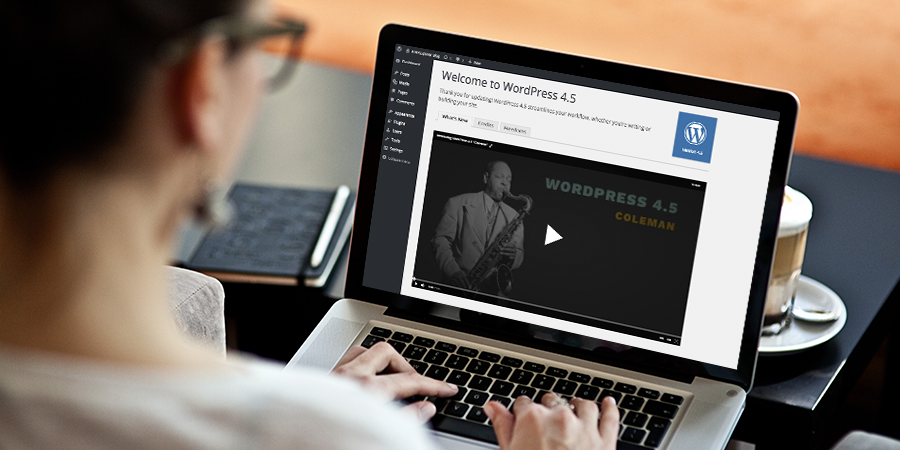
In April, WordPress 4.5 “Coleman” was released to bring us features like inline links, more editor shortcuts (for horizontal lines and code formatting) and custom logo support. And just like the preceding updates 4.5 included improvements to the live Customizer as well. This time live responsive previews were added so users can get a good look at their designs on desktops, tablets and mobile.
Updates:
- April 26, 2016 – WordPress 4.5.1 Maintenance Release
- May 6, 2016 – WordPress 4.5.2 Security Release
- June 18, 2016 – WordPress 4.5.3 Security & Maintenance Release
- June 30, 2016 – WordPress 4.6 Beta 1
- July 6, 2016 – WordPress 4.6 Beta 2
- July 13, 2016 – WordPress 4.6 Beta 3
- July 20, 2016 – WordPress 4.6 Beta 4
August 16, 2016 – WordPress 4.6 “Pepper”
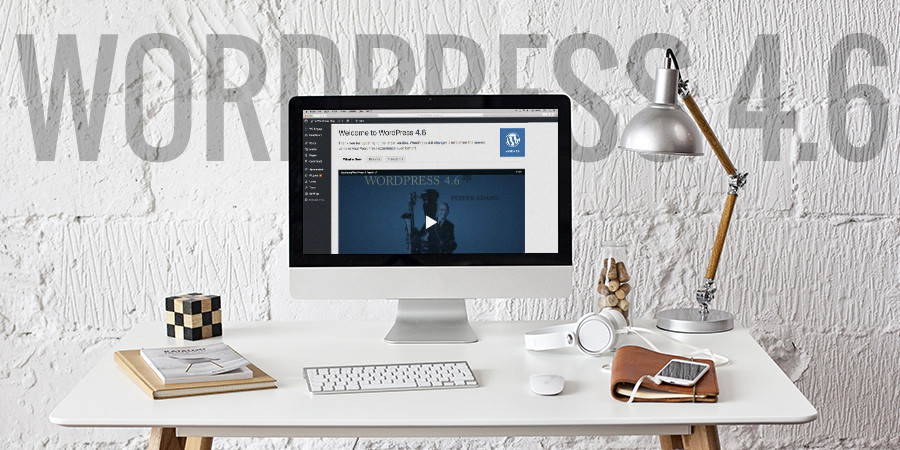
WordPress 4.6 didn’t add a ton of new features, but the most helpful was probably being able to (finally) install/update plugins or themes without being navigated through a series of pages.
Since 4.6 you can click to update and stay on the same page. Other notable features include the addition of native fonts to speed up the dashboard loading time, inline broken link checker and improved auto-saving for content recovery.
Updates:
- September 7, 2016 – WordPress 4.6.1 Security and Maintenance Release
- October 28, 2016 – WordPress 4.7 Beta 1
- November 4, 2016 – WordPress 4.7 Beta 2
- November 11, 2016 – WordPress 4.7 Beta 3
- November 16, 2016 – WordPress 4.7 Beta 4
- November 24, 2016 – WordPress 4.7 Release Candidate
December 6, 2016 – WordPress 4.7 “Vaughan”
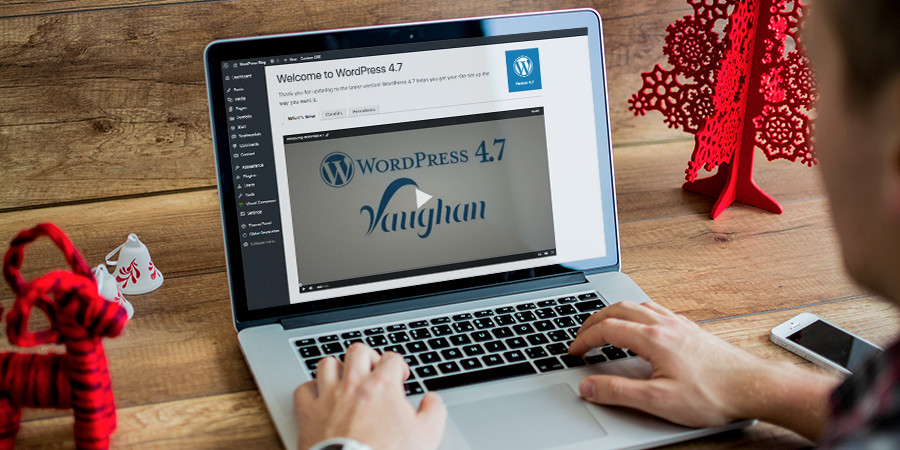
WordPress 4.7 allowed us all to end 2016 with some awesome new options. This WordPress core update added the ability for theme developers to add sample content to their themes. Improvements to the WordPress Customizer were also made, such as added menu building, quick-links (those little blue pencil icons) to edit defined components of your theme and instant custom CSS previewing. This version of WordPress also added the ability for all users to set their dashboard language making it easier for collaborations across the globe.
And for those of you curious about the REST API, this is also the point in WordPress history where endpoints were added for posts, terms, meta, comments, users and settings to give a solid base for future developments.
Updates:
- January 11, 2017 – WordPress 4.7.1 Security and Maintenance Release
- January 26, 2017 – WordPress 4.7.2 Security Release
- March 6, 2017 – WordPress 4.7.3 Security and Maintenance Release
- April 20, 2017 – WordPress 4.7.4 Maintenance Release
- May 13, 2017 – WordPress 4.8 Beta 1
- May 16, 2017 – WordPress 4.7.5 Security and Maintenance Release
- May 23, 2017 – WordPress 4.8 Beta 2
- May 25, 2017 – WordPress 4.8 Release Candidate
- June 1, 2017 – WordPress 4.8 Release Candidate 2
June 8, 2017 – WordPress 4.8 “Evans”
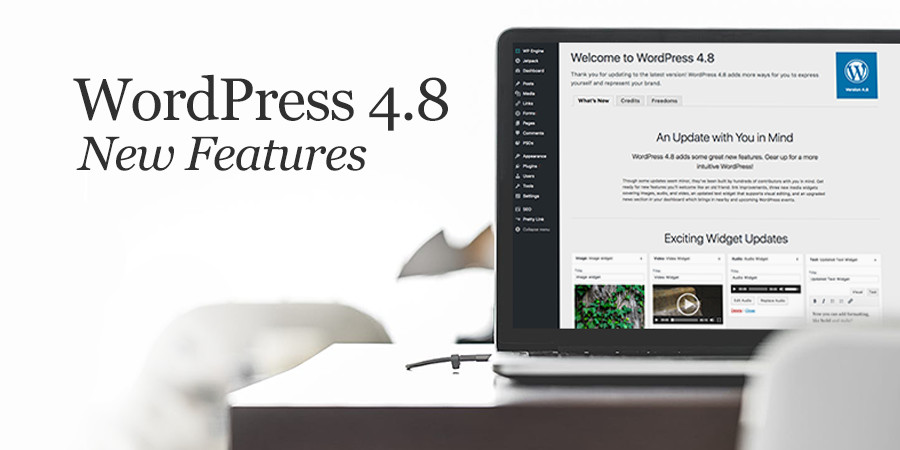
“Evans” was a fairly low key release compared to it’s predecessor, but still added a couple fun new features for WordPress users. Automattic added in new media widgets that made it easier to insert images, audio and videos in sidebars or footers.
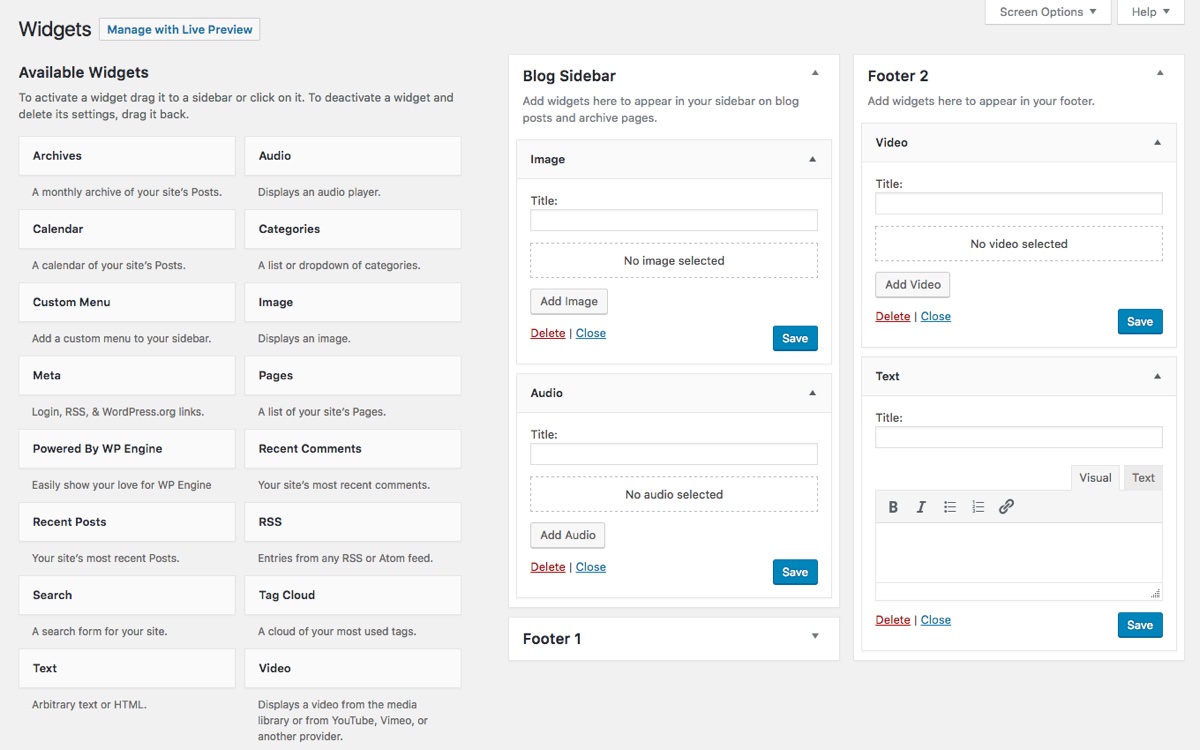
Plus they overhauled the text widget to now include rich-text editing (so no more having to add in your own html for text styling). WordPress 4.8 also added a new dashboard welcome widget for local-to-you WordPress events and new link boundaries when editing your posts and pages (just click once to select the full link), but that’s pretty much it.
Updates:
- August 2, 2017 – WordPress 4.8.1 Maintenance Release
- September 19, 2017 – WordPress 4.8.2 Security and Maintenance Release
- October 5, 2017 – WordPress 4.9 Beta 1
- October 12, 2017 – WordPress 4.9 Beta 2
- October 19, 2017 – WordPress 4.9 Beta 3
- October 25, 2017 – WordPress 4.9 Beta 4
- October 31, 2017 – WordPress 4.8.3 Security Release WordPress 4.9 Release Candidate
- November 7, 2017 – WordPress 4.9 Release Candidate 2
- November 14, 2017 – WordPress 4.9 Release Candidate 3
November 15, 2017 – WordPress 4.9 “Tipton”
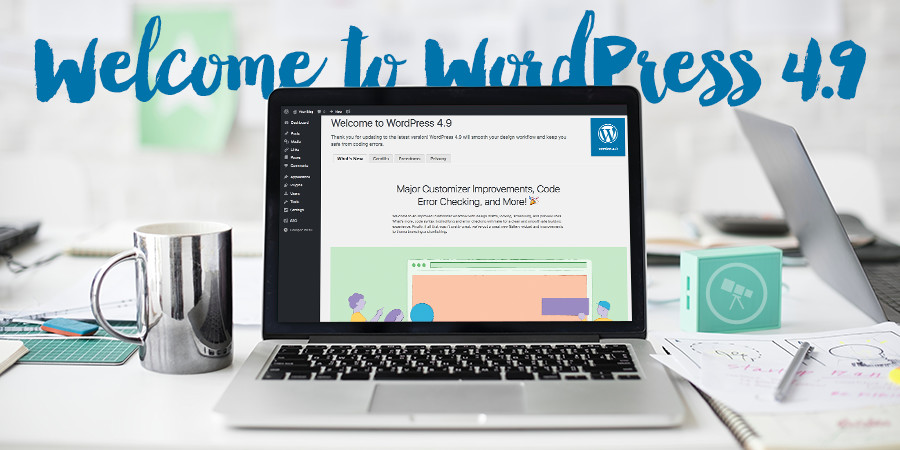
This update added the ability for users to save Customizer drafts so you could work on site updates but not have to commit them yet, giving you ample time to perfect your design before taking it live. Equally as awesome – this new feature also added a scheduling option making it a great way to plan out holiday or promotional site additions.
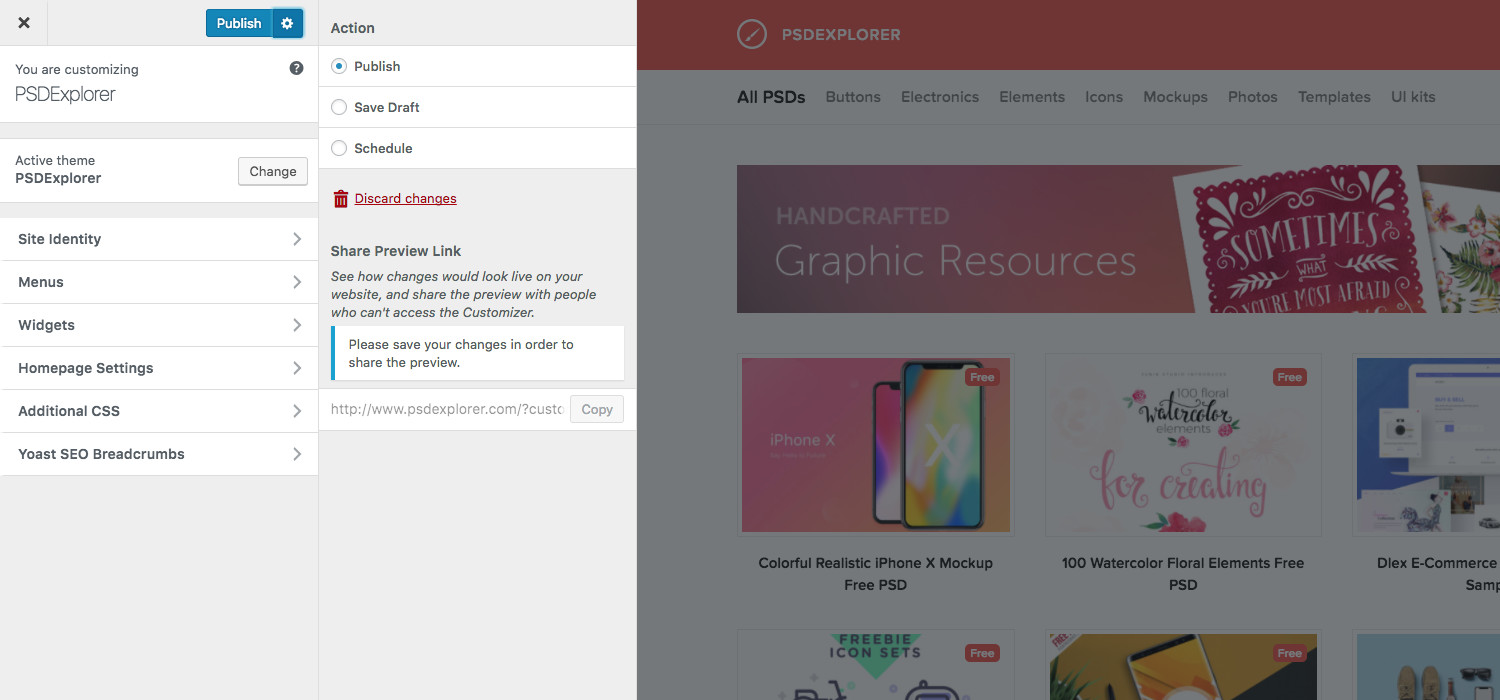
WordPress 4.9 also added another widget (this time for image galleries), Customizer live theme previewing, menus and widget reliability when switching themes (they finally consistently stay put!) and coding enhancements for syntax highlighting if you’re using the WordPress Editor to make changes (which we recommend against – we strongly believe in using a child theme if you want to make tweaks). This is also where Automattic put out an official call for Gutenberg testers signaling that the builder will most definitely be a part of WordPress and soon.
There have also been a number of smaller maintenance releases this past year, but the most notable is certainly the WordPress 4.9.6 privacy update. This added new privacy features to help make WordPress GDPR compliant. Most importantly a privacy policy template, comments cookie optin, as well as easy user data request/export/erase.
Updates:
- November 29, 2017 – WordPress 4.9.1 Security and Maintenance Release
- January 16, 2018 – WordPress 4.9.2 Security and Maintenance Release
- February 5, 2018 – WordPress 4.9.3 Maintenance Release
- February 6, 2018 – WordPress 4.9.4 and Maintenance Release
- April 3, 2018 – WordPress 4.9.5 Security and Maintenance Release
- May 17, 2018 – WordPress 4.9.6 Privacy and Maintenance Release
- July 5, 2018 – WordPress 4.9.7 Security and Maintenance Release
- August 2, 2018 – WordPress 4.9.8 Security and Maintenance Release
Upcoming WordPress Version 5.0
WordPress 5.0 is slated to land with all new Gutenberg content building goodness on November 19, 2018 (you can follow along on the core track). To be honest, we weren’t 100% sure Gutenberg would launch with 5.0 but it looks like the dev team is pushing forward. The bigger surprise is that 5.0 may launch without the Twenty Nineteen theme (as it’s not yet ready) – so we’ll just have to wait and see!
Now What…
What do you think is next for WordPress? Are you a developer and believe WordPress is missing an important feature? Well, share with us or head over to WordPress.org and become a contributor. The WordPress project is always in need of a new pair of hands.
We always welcome your thoughts on WPExplorer.com, so contribute freely in the comment section below. We’d love to hear what you think is coming for the future of WordPress.




Nice Article Freddy
Thanks Emmanuel!
Great piece of material in this look-back machine piece. Thanks.
A wee typo to correct at
April 16, 2012 – WordPress 3.9 “Smith”
On the 16th day of April 2014, WordPress 3.9 named “Smith” dropped.
Oops! Thanks for letting us know 🙂
Worpress for android, ios and blackberry is available. I guess its high time Windows phone OS joins.